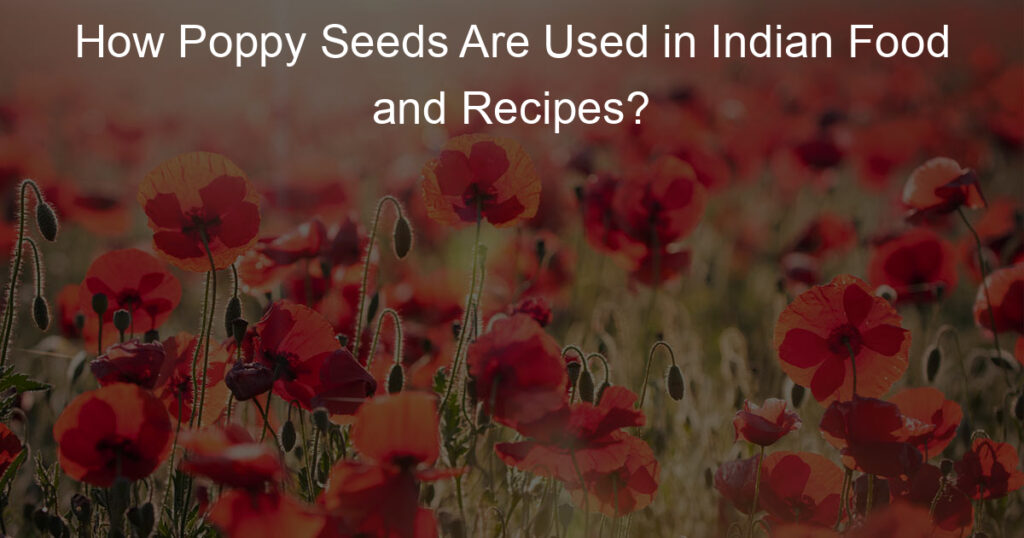If you have ever met a person from India, then you probably know about its rich culture and cuisine. Indian cuisine is famous across the world for its variety of recipes and delicious foods that are prepared using traditional ingredients. Poppy seeds are one such ingredient that plays an important role in many Indian recipes. These tiny black seeds are used to add the right amount of crunch and saltiness to many savory dishes, helping them taste even better.
These tiny black seeds known as poppies or white lupins (also called blue lupins) grow in fields all over India. Their seed pods are used to prepare a paste for cooking various dishes and snacks in Indian vegetarian restaurants, home kitchens, hotels, private lodges etc. The common types of poppies that grow in India are black or red poppy seeds; both varieties have their own unique flavor and aroma. Black poppy seeds have a stronger, more bitter taste than red ones. You can find these seeds at any grocery store where they sell spices. Red or Madras poppy seeds come from red flowers which also adds to their distinct sweetness when raw with other ingredients or when cooked into different dishes under the right circumstances. Red or Madras poppy seed paste is commonly used as toppings on dosa batter pancakes, idli pancakes, chutney sambar, salads, pickles etc… This post will help you understand how poppies are used in various recipes around the world but primarily found within the Indian subcont
What Is Poppy Seed Called In India?
In India, poppy seeds are known as “sura” or “kalmi”. In other parts of the world, this seed is often called “poppy nut,” “caraway seed,” or “marjoram.” It is usually found in recipes in which it adds a salty and crunchy texture to dishes.
On the other hand, red or Madras poppy seeds are also called “suntan” in southern India. Red or Madras poppy seed paste is also used frequently as toppings on dosa batter pancakes, idli pancakes, chutney sambar, salads, pickles etc…
How Do You Use Poppy Seeds in Food?
Poppy seeds are used in many foods like Indian sweets, chutney, pickles and more. Black poppy seed paste is often added to dosa batter and idli batter to add a lightly crunchy texture. You can also find it in desserts like halwa, gulab jamuns and rasmalai. The red variety is commonly used as a topping on dosa pancakes, iddli pancakes and salads. In North India, the red variety is more common because of the availability of the flower where it grows.
Poppy seeds are also used in breads like naan or paratha to give it an extra flavor boost. It might seem unusual to use this type of seed for breads but you will soon discover that these tiny black seeds have the unique ability to add flavors that are milder than your typical yeast-based bread recipe. These seeds can also be sprinkled on dishes like raita or mixed with yogurt or other salad ingredients or vegetables for a taste boost. You can make sweet treats with these as well by mixing them into sugar syrup and adding them to your favorite fruits for an exotic taste sensation!
What Dishes Have Poppy Seeds in It?
Poppy seeds are used in many different dishes, including meat-based ones as well as vegetarian ones. Meat dishes that have poppy seeds in them include Chicken Tikka Masala, Beef Korma, Butter Chicken, and Lamb Vindaloo. Vegetarian dishes that use this ingredient include Paneer Tikka Masala, Palak Paneer, Saag Paneer, Samosa Chaat, and Chana Masala.
Some of the other dishes that contain these tiny black seeds are:
– Bhaji
– Curry
– Dosa
– Idli
– Kadhi
– Korma
– Salsa
– Satay Sauce
– Raita
Do You Have To Cook Poppy Seeds To Eat Them?
Poppy seeds are roasted, fried and ground to produce a powder that is added to different foods. They are soaked in water for a few hours before cooking them into dishes to create the best result. The process of preparing poppies is called delousing.
The best way to cook these seeds is in a dry pan on medium heat until they turn light brown or golden-brown and then remove from heat.
The seeds can be consumed raw or slightly cooked with other ingredients but should not be boiled or soaked as it will become too soft. You must also make sure that you store them in an airtight container so that they donג€™t lose their crunchiness and taste while they’re stored at room temperature.
One essential thing you need to know about poppy seed paste is that it has a strong odor when it’s first made so you’ll need to change your environment by opening the windows or doors if you live in an apartment or house where there is no ventilation. If your kitchen doesn’t have ventilation, consider moving the dish outside onto the balcony or porch for about 30 minutes so that the smell diminishes and won’t overwhelm everyone who enters your home during this time period














